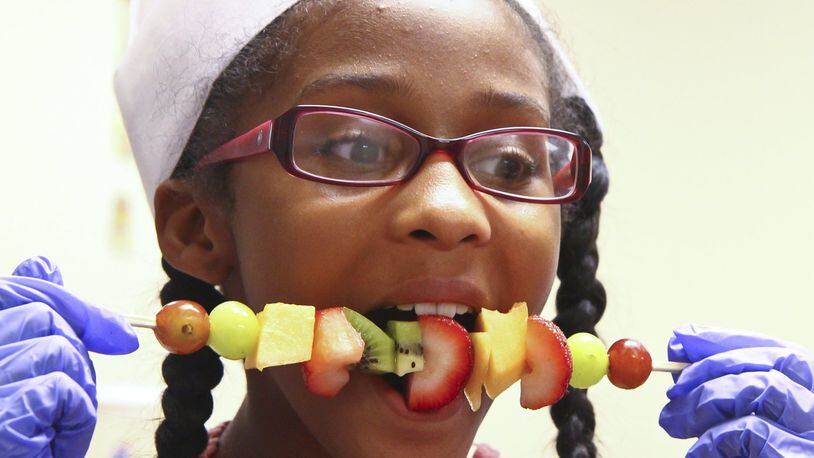RELATED: Springfield, Clark County work to shed unhealthy image
MORE COVERAGE: Healthy Springfield series
They all pretty much agreed on quinoa, green leafy vegetables, nuts, berries, and something called cauliflower rice that you can now find in the freezer aisle. There was some debate on watermelon seeds. Apparently these are the new “seed” of the moment, and one Program Assistant with a sweet tooth informed me that you could even buy them dipped in chocolate. The problem was, no one could agree if this was a fad or if there was any chance of its longevity in the snack aisle.
In Clark County, Program Assistant and vegan Erin, (who had a difficult time narrowing it down to seven) had her own ideas about what she should be eating when the New Year rolls around. She also included quinoa (provides protein), kale (contains Vitamin A), broccoli (Vitamin C), kiwi (Vitamin C), oatmeal (Fiber), blueberries (fiber and Vitamin C) , chia seeds (potassium and iron), lentils (protein), black beans (protein and fiber) and sweet potatoes (Vitamin A).
When I asked my daughter—who attends college in Akron — what healthy additions she could add to her diet, she took the challenge pretty seriously. After a couple of days she texted me this message: “I need to start eating baked chips, instead of fried, Lean Cuisines instead of pizza rolls, any kind of milk, vegetables without ranch dressing. Oh yeah, and I should switch to light beer, and cut back on coffee.” Pretty insightful for someone who buys ramen noodles by the case.
Finally, my colleague, Amy Habig in southern Ohio sent me a list as well. As a Dietitian, she also had a difficult time narrowing it down to seven specific foods:
Canned or dried beans: They are a low-fat protein source with fiber. These can be used as the protein source in main dishes. Having at least one plant-based meal per day can be great for health.
Low-fat or fat-free milk: Milk has calcium and vitamin D. It is also a good source of several other nutrients. It contains quite a bit of protein and is pretty filling.
Whole grain foods: These contain B vitamins and fiber. Fiber helps keep us regular, and can help lower cholesterol.
Fruits: No matter whether they are fresh, canned, frozen, or dried, fruits are a source of many important vitamins and minerals…..and they are low in calories. They naturally contain fiber.
Vegetables: Just like fruits, vegetables are a source of many important vitamins and minerals no matter whether they are fresh, canned, frozen, or dried, are also low in calories and naturally contain fiber.
Foods that are low in added sugars such as fresh fruits and vegetables and unsweetened dairy products. Many beverages and desserts contain added sugars; consume those items in moderation.
Foods low in sodium such as fruits, vegetables, and unprocessed foods. Processed and pre-packaged foods are the largest contributor of sodium in the diet.
As you can see, there are many different opinions about what a healthy diet looks like. We talk a lot in our classes about making small changes, eating things that may not be so good for you in moderation and understanding that bad habits are difficult to break — so don’t be too hard on yourself.
For example, if eating a bowl full of kale does not appeal to you, try putting some on your favorite sandwich. If you can’t imagine eating a sweet potato without brown sugar, butter and marshmallows, try cutting back on these ingredients a little bit at a time. If you don’t think you can give up pasta, try switching to whole grain. Small changes really can add up to healthy eating.
Nancy Doyle-Lyons is a program specialist at the Ohio State University Extension Office in Montgomery County.
Looking for a healthy delicious dip to try out on New Year’s Eve? Consider one of these healthy options:
Garlicky Herb Dip
Makes 2 cups
Ingredients:
1 cup plain low-fat Greek yogurt or ricotta cheese, or a combination
½ cup chopped fresh Italian flat leaf parsley leaves
2 garlic cloves, minced
1 teaspoon dried basil
1 teaspoon dried oregano
½ teaspoon dried thyme
½ teaspoon black pepper
¼ teaspoon salt
Mix all ingredients well, Serve right away or refrigerate up to 2 days.
Chunky Artichoke-Bean Dip
Makes 2 cups
Ingredients:
1 (15 ounce) can white beans, drained and rinsed
1 (14 ounce) can artichoke hearts, drained and rinsed
3 tablespoons olive oil
2 garlic cloves, minced
¼ cup fresh basil, chopped
¼ cup Parmesan cheese
1 teaspoon dried basil
Juice and grated zest of one lemon
¼ teaspoon salt
¼ teaspoon pepper
Mix together in food processor until chunky-smooth, or put in bowl and mash with a fork until chunky.
Serve right away or refrigerate up to 2 days
Sweet Sesame Almonds
Makes 2 cups
Ingredients:
2 cups raw almonds
2 teaspoons maple syrup or honey
½ teaspoon salt
¼ teaspoon ground cinnamon
¼ teaspoon chili powder
2 tablespoons toasted sesame seeds.
Directions:
1. Preheat oven to 250 degrees F
2. Put almonds, syrup or honey, salt, cinnamon and chili powder in bowl and mix well.
3. Spread on baking sheet in one layer. Bake until nuts are shiny and lightly roasted, about 20 minutes.
4. Remove sheet from oven. Add sesame seeds and mix well, until most of seeds are stuck on almonds.
5. Carefully remove almonds from sheet.
6. Cool and Enjoy!
Healthy Springfield: About this series
Many readers responded to a report late last year that ranked Springfield as the least healthy city in Ohio. That response — including wanting to make a positive difference — prompted the Springfield News-Sun to take a closer look at the community’s health. This year the News-Sun dug into the public health issues facing the city, including obesity and minority health disparities and efforts to improve them.
About the Author
